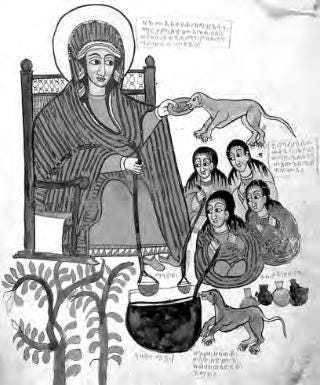We all have those love/hate relationships with things we know don’t exactly tell the whole story but tug at our difficult-to-tune heart strings. Discernment between ennobling cultural traditions and the merely sentimental is often elusive and temptation lurks, Grinch-like, to join the cancel choir that brings condemnation without hope. But love teaches a better way of truth telling.
To that end, this blog post offers some clarity about a beloved Christmas song easily recognized by its refrain that is also its title. Mary, Did You Know? is a moving and emotional song filled with truth about Jesus that exalts his deity and works of righteousness and justice which are its best parts but is not its central theme.
What Did Mary Need to Know?
Throughout the song Mary, the virgin mother of Jesus, is plied with a series of questions that increase in intensity and scope. Here a list of things Mary was asked if she knew:
That your baby boy would walk on water?
That your baby boy would deliver you? Came to make you new?
That your baby boy would save your children?
That your baby boy would give sight to those who had none?
That your baby boy would calm a storm?
That your baby boy walked with angels?
Also did you know that when you kiss him you are kissing God?
Also would heal people and resurrect people?
Is the Lord of all creation?
Would one day rule nations
Is heaven’s perfect lamb?
That you are holding YAWEH???
This song does not center on the person and work of Jesus, but centers on the question of whether or not Mary knows about her child. The lyrics point to the irony of the young woman cuddling her baby boy who is actually God, and that Mary may not realize it.
This is evident by the repetition of lines. The question “Mary, did you know?” is asked so often, 23 times in fact, that it is clear that Mary did NOT know, or seemed to have once known but forgot and needs reminding. The repetition of “your baby boy” communicates Mary’s point of view of her child to which someone else must enlarge to include his deity and majesty. It paints a picture of a naive little girl playing with a baby doll.
Infantilizing: “treating as a child or in a way which denies a person’s maturity in age or experience.”
Infantilizing women robs image-bearers of their personhood. It reinforces their assumed fragility and naïveté that remains incomplete without the presence of a man who must enlighten her and make her wise. This traditional rendering sees Mary as a delicate little lady among the stable stuff. Our nativity scenes depict hay and animals and troughs as unfamiliar and out of tune as if Mary recently descended from some Victorian parlor with scented handkerchief over her fine porcelain nostrils.
Sentimentalism feeds cultural traditions of misty-eyed sweetness that neither informs or nourishes.
What DID Mary Know?
The angel Gabriel was sent by God to visit Mary who assured her she found favor with God. The angel tells Mary that she will conceive and deliver a son who “will be great and will be called the Son of the Highest, and the Lord God will give Him the throne of His father David.” And he will reign forever with no end to his kingdom. Gabriel told her about her cousin Elizabeth, who was formerly barren, now carries a son. Mary and Gabriel speak to one another, she believes the message and enthusiastically embraces her mission.
Mary was young, not the equivalent of a 13-year old living in the US in 2022, but young nevertheless, and her mission was massive even for one with the broadest and strongest of shoulders. She was alone in her experience of a very strange and supernatural conception. She knew that she faced a life of shame and dishonor by her community who would not know or understand.
But Mary had prepared herself. She knew the scriptures and the promises of God. She understood the grace of God, and the strength He gives. She knew the justice of God and His upside down kingdom that lifts the poor and lays low the mighty. She knew the promises would be fulfilled.
She gets with her cousin and together they prophesy on another. This is when Mary, intelligent and theologically astute, breaks forth in her famous “magnificat.” Later with her son, Mary receives the prophecy of Simeon who speaks of a sword that will pierce her soul in relation to Jesus’ mission. Her son’s messiahship is validated by both Simeon and Anna the prophetess. Mary receives those words from the Lord.
And Mary said:
My soul magnifies the Lord,
and my spirit rejoices in God my Savior,
for he has looked with favor on the lowliness of his servant.
Surely, from now on all generations will call me blessed;
for the Mighty One has done great things for me,
and holy is his name.
His mercy is for those who fear him
from generation to generation.
He has shown strength with his arm;
he has scattered the proud in the thoughts of their hearts.
He has brought down the powerful from their thrones,
and lifted up the lowly;
he has filled the hungry with good things,
and sent the rich away empty.
He has helped his servant Israel,
in remembrance of his mercy,
according to the promise he made to our ancestors,
to Abraham and to his descendants forever.” The Song of Mary, Luke 2:46–55
Mary knew a great deal.
Why It Matters to Me
For over thirty years male historians, professors, preachers, and teachers have taught, challenged and edified me in the words and ways of God. Only recently have I experienced exhortation, comfort and encouragement from other Christian women who hold public platforms that are not strictly segregated to “women’s only” spaces. These women are dismissed as lesser than their male peers simply for existing as women who think, write, and speak with authority and erudition to a wider audience than the Ladies’ Teas.
When popular literature portrays Mary, the mother of the Lord Jesus Christ and commissioned by the God of the universe, is reduced to a child who must be catechized, we need to pause. Scripture gives plain and strong testimony of Mary’s swift embrace of her remarkable role in the fulfillment of the LORD’s old covenant promises.
I began at Jesus’ birth, and I end at his death and resurrection: another Mary prepared Jesus for His burial and publicly proclaimed him as Messiah by anointing his head with oil before her detractors. The “Marys” and other women followed him and remained with him throughout his execution when all others had fled. At his empty tomb, the resurrected Jesus commissioned women to proclaim to the doubtful disciples that he gained the victory over death!
When Christian men resist treating women as equals in intellect, competency, grit, emotional strength and endurance, they surrender their opportunities to treat us as Jesus did and does.
The Christmas and gospel story does not need our pretty adornments to bolster the truth and make it culturally palatable: we must unpack the awesome majesty as it is to elicit awe and worship.
And, if it is a woman who does the unpacking, then listen up–you just might catch a glimpse of something you didn’t see or know before.











